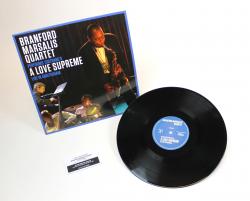 Coltrane’s A Love Supreme: Live in Amsterdam reissue from the Branford Marsalis Quartet out now and available on vinyl for the very first time Read more »
Coltrane’s A Love Supreme: Live in Amsterdam reissue from the Branford Marsalis Quartet out now and available on vinyl for the very first time Read more »
Review: Miguel Zenón at Jazz Showcase "…this music deserves to be heard at full cry."
Date: 10.10.2009
Publication: Chicago Tribune
Author: Howard Reich
Since its inception, jazz has been an international music, drawing deeply on influences from the Caribbean, Africa and Europe.
But its global voice never has been more pronounced than in the past 20 years, thanks to the stylistic breakthroughs of Panamanian pianist Danilo Perez, Puerto Rican saxophonist David Sanchez, Chilean vocalist Claudia Acuña and many more.
At 32, alto saxophonist Miguel Zenón is younger and less widely known than these great artists, notwithstanding the MacArthur “genius grant” he won in 2008. Yet he ranks among them for his insights in applying the musical rituals of his native Puerto Rico to jazz improvisation and composition.
Zenón makes the point more intensely than ever on his newest recording, “Esta Plena” (Marsalis Music), its repertoire serving as the centerpiece of a revelatory show Thursday night at the Jazz Showcase, where he plays through Sunday.
The title of Zenón’s recording translates to “This Is Plena,” and, indeed, both the CD and Zenón’s engagement at the Showcase likely will introduce many listeners to Puerto Rican “plena” music. Or at least a form of it, refracted through Zenón’s jazz sensibility.
Zenón, in other words, doesn’t revisit age-old plena songs or cling entirely to its traditions. Instead, he has created original compositions that invoke plena song forms but also push well beyond them. Cultures converge in his music, a dynamic merger of Puerto Rican rhythm and its intricate jazz counterparts.
As Zenón’s songs unfold, audiences hear an ebb and flow of ideas between cultures, as if Caribbean music and its jazz offshoots were conversing. In some sections of this music, Zenón and vocalist Hector “Tito” Matos chant in unison, accompanying themselves on “panderos” (hand-held Puerto Rican drums). Though the tunes are newly penned by Zenón, they evoke singing styles that have flourished in Puerto Rico for roughly a century.
Yet when the vocals subside and Zenón’s instrumental ensemble takes the lead, the music bristles with harmonic sophistication and rhythmic complexity. The music Zenón heard growing up in Puerto Rico essentially has provided a springboard for aggressive ensemble improvisation and freewheeling solos.
The boldness of this music was apparent from the start, Zenón and the band launching their first set with the high spirits and exuberant rhythms of the recording’s title cut. To hear Zenón and Matos finessing vocal lines that bobbed and weaved around the beat, while the band pulsed behind them, was to understand instantly the emotional power of this cross-cultural merger.
Not all of this music, however, surged relentlessly from one offbeat to the next. In “Pandero y Pagode,” Zenón and Matos sculpted gorgeously shaped vocal lines at a medium tempo, with gentle accompanying filigree provided by pianist Luis Perdomo. Here was the plena-jazz connection at its most accessible.
It’s doubtful that Zenón could have incorporated plena music into jazz so dexterously without having worked with this same instrumental quartet for so many years. Luis Perdomo’s warmly voiced pianism, Hans Glawischnig’s sonorous but nimble bass and drummer Henry Cole’s delicately articulated layers of rhythm represented a natural extension of Zenón’s ideas.
Though microphone woes sometimes caused an imbalance between vocals and instrumentals, one hopes the problem can be corrected quickly, for this music deserves to be heard at full cry.
Categories
Tags in Tags
Branford Marsalis Branford Marsalis Quartet ellis marsalis four mfs playin' tunes Joey Calderazzo Justin Faulkner Marsalis Family marsalis music metamorphosen miguel zenon music redeems new orleansFilter by Artist
Marsalis Music Radio
Join Our Mailing List
- RT @bmarsalis: Compliments of the @T_Blanchard archives. https://t.co/4RsXbyEloa — 3 years 9 weeks ago MarsalisMusic